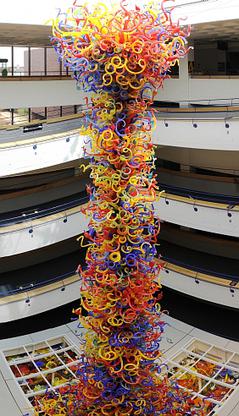Sculpting Explained
To put simply, sculpting is the art of creating objects by shaping materials. This shaping can be carving, where material is removed from an object like marble to reveal form, or modeling, where the artist creates form by adding materials, such as clay. The process of sculpting starts with the artist conceptualising a particular subject. Subsequently, the artist decides the size of the sculpture and material to be used.
Materials Used in Sculpting
Sculpting can be done with a range of materials including clay, metal, wood, glass or stone. For beginner sculptures, clay is the best material to get started. Once you master sculpting with clay, it can be easier to progress to other materials like stone or wood. Clay for sculpting is available in different types, such as plastilina or oil-based clay, ceramic clay, or polymer clay. You can choose any of these clay types, depending on your preferences for feel and hardness of the material.

Image source: https://cdn.pixabay.com/photo/2015/05/26/19/40/clay-figure-785230__340.jpg
Basic Technique of Sculpting with Clay
Before getting started with clay sculpting, the artist needs to have a clear mental visual of the final output. Based on this mental image, they should create a sketch of their intended design. Interestingly, the practice of creating a sketch before sculpting has been followed by all-time great sculptures like Michelangelo. Ideally, it is useful if the sketch is of the same size as that of your intended sculpture.

Image source: https://cdn.pixabay.com/photo/2015/09/05/00/17/hand-923436_960_720.jpg
Once the sketch is ready, you should create a support structure, also known as armature, for your sculpture. To put simply, the armature is a skeleton of the sketch. Typically, the armature is made from lightweight and non-corrosive material such as aluminum wires.
Next, you add a filler around the armature. The filler could be made out of any lightweight and cheap material like newspapers, tin or aluminum foil or even a cheaper variant of clay.
Finally, you start adding the sculpting material to the filled armature. To start off, begin with the large sections to define a broad shape of the sculpture. Next you can start adding clay to the smaller sections. Both the larger and the smaller sections can be created by hand without requiring any sculpting tools. Make sure to shape all sides gradually. One should avoid the mistake of focusing on a single area alone, as that can lead to an imbalance. It is a good idea to occasionally move away from your design and assess your work-in-progress from all sides.
Once you have the basic form in place, you can start sculpting the minute details using modeling tools. These tools come in a range of shapes and sizes for different purposes like cutting, shaping and detailing. For absolute beginners, a wet sponge can be handy for smoothening the different shapes of the sculpture. Other simple modeling tools for beginners include household items like toothpicks, toothbrushes, sewing needles, combs, etc.

Image source: https://c1.staticflickr.com/8/7427/8719848461_899687017d_b.jpg
Finally, after your clay sculpture is ready, you have the option of hardening it by curing. Depending on the type of clay, different methods of curing, such as air drying or baking, can be used. Check out the instructions by the manufacturer for the appropriate method.
If you want, you can also paint your finished sculpture. For most types of clay, acrylic paint can be used. You may also add gloss to areas like eyes to give them a more realistic look.
Famous Sculptures from Different Materials:
Stone: Sculpting by stone is an ancient art, and thus you will find a lot of stone sculptures that have been created in prehistoric times. In modern times, some of the famous stone sculptures are The Kiss (1907) by Constantin Brancusi and Kneeling Woman (1911) by Wilhelm Lehmbruck.

The Kiss by Constantin Brancusi
Image source: https://www.flickr.com/photos/posk/7876812498/in/photostream/
Marble: “David” by Italian artist Michelangelo is one of most popular marble sculptures. This 17-feet statue showcases David, the Biblical hero, in a nude state. Other famous marble sculptures are Moses and Pieta (both by Michelangelo), and Venus de Milo, a famous Greek statue, which is on display at the Louvre museum, Paris.

Moses by Michelangelo
Source: https://en.wikipedia.org/wiki/Moses_(Michelangelo)#/media/File:Moses_Michaelangelo_September_2015-1.jpg
Metal: Prominent metal sculptures are Bronze David, made in the 15th century, by Donatello, and Bird Girl (1936) by Sylvia Shaw Judson. The Statue of Liberty is another iconic sculpture, made out of metal.

Statue of Liberty
Source: https://en.wikipedia.org/wiki/Statue_of_Liberty#/media/File:Statue_of_Liberty_7.jpg
Glass: Fireworks of Glass, a 43-foot permanent structure made of blown glass by Dale Chihuly, is a celebrated masterpiece in glass sculpting.

Fireworks of Glass by Dale Chihuly
Image Source: https://en.wikipedia.org/wiki/Fireworks_of_Glass_Tower_and_Ceiling#/media/File:Fireworks_of_Glass.jpg
To summarise, sculpting is a unique art form with a rich history. Because of its three-dimensional nature, sculpting is a much more effective way of expressing creativity than say painting or drawing. Like all art forms, sculpting requires a lot of practice. But once you get a hang of it, you can create lots of attractive sculptures, such as Ganapati statues, which can be used as showpieces either in your home or for gifting to others.